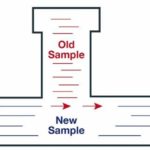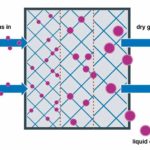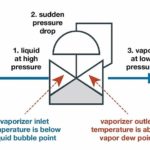Downtime, potential economic loss, and even safety concerns can arise if any elements of the sampling system were to malfunction. This article provides an overview of problems in sampling systems that Swagelok field engineers frequently encounter and shows how to solve them.
For instance, problems can often occur during analyser maintenance. Often, the challenges require maintenance technicians to spend more than an acceptable amount of time working on the analyser, sometimes working into the middle of the night or on weekends. Frequently auditing analysers and fixing simple sampling system design flaws can significantly boost the reliability of a plant’s analysers. The Swagelok field engineers have identified many potential problems that are easy to fix, such as reversed check valves blocking the sample flow or a fast loop flowing backwards.
Pay attention to the design
Some of the more common issues facing sampling systems are caused by poor design, and they can produce long-term problems over the lifetime of systems. For example, field engineers frequently discover inadequate fuel line heating. If the line has no heat when it should or is too hot that it polymerises or decomposes the sample, then the system will not function properly. It is important to ensure proper training for field engineers via qualified training programs that cover the basic intricacies and design principles for creating sampling systems. To help plants improve outcomes, Swagelok offers a variety of process analyser sampling system (PASS) training courses.
Considering time delay
Evaluating process analysers can be even more complicated due to nonobvious problems that may arise. For example, time delay is a frequent consideration, as the industry standard is one minute between the time the sample is extracted from the process and transported to the analyser. This short time frame provides near real-time readings of process conditions, enabling technicians to make immediate adjustments and minimise wasted product.
Unfortunately, analysis delays can take as long as hours and even days. Any information from the analysis is therefore useless because it does not represent the real-time product in a system. Such delays could lead operators to act on inaccurate information about the sample and make ineffective corrections. Often, operators are unaware of the extent of a time delay, which means inferior product will continue to move through the system and may even be shipped to customers before discovering any quality issues. To combat time delays, the only solution is to adjust the system’s design. If done correctly, such modifications can significantly reduce delays down to the one-minute industry standard.
Unrepresentative samples
Operators can take samples correctly and limit time delay, but if the sampling system design is improper, analyser results may still be wrong. For instance, deadlegs – dead spaces in the process analyser system – sometimes cause old samples to mix with new samples, preventing the sample from accurately representing real-time process conditions. Another reason samples could be tainted are leaks from the surrounding ambient air. For instance, oxygen could leak into a system that is supposed to be 100 % nitrogen at 100 psia because the partial pressure of the oxygen outside exceeds the partial pressure in the system. Operators can alleviate such problems by increasing the partial pressure of the sampling system to equalise the two, which would prevent unintentional ambient air contamination.
The reality of coalescers
While coalescers are commonly understood as devices that separate and remove liquids from gas samples, that is only partially true. Coalescers only work if the sample liquid is aerosolised because they are designed to cause the small aerosol droplets to collect together into large drops that are then easily separated by gravity.
A common challenge is that the coalescer can be rendered useless by one of two sce-narios. First, nonaerosolised liquids will travel through a coalescer with little or no separation because of the large size of the liquid droplets. Second, fine aerosol droplets will pass through the coalescer and will not be separated if the flow rate through the coalescer is too high. In both cases, liquid will reach the analyser and lower the reliability of your readings.
Turning a liquid into vapour is difficult
Vaporising liquids can seem deceptively easy, but it is not as easy as it looks. While it may appear simple to drop the liquid’s pressure rapidly to achieve vaporisation, it is just as possible that you will end up creating a fractionated sample due to a combination of vaporisation and evaporation. Once that happens, the sample is no longer valid for analysis.
When fractionalisation happens (as is common in sampling systems), heavier molecules stay behind in the liquid phase while lighter gas molecules move downstream to the analyser as an unrepresentative sample. Once you understand what happens during vaporisation and how to manage it, it is
easier to stop it in the future.
Condensation is an easy fix
The most frequent problem with gas samples is condensation. Thankfully, it is fairly easy to both predict where it may occur and fix the problem. It is usually just a matter of figuring out the right temperatures (after all, gases cool down quickly, while liquids take far longer to cool).
Field stations often include systems that reduce the pressure of a gas sample (which should be done as close to the tap as pos-sible). Nearly every gas loses heat during a pressure drop thanks to the Joule-Thomson effect. Measuring the amount of the drop allows you to determine whether a simple pressure-reducing regulator will suffice to accommodate a minor pressure drop or if other options have to be considered to handle a significant pressure drop.
Why bring in an expert evaluator?
Getting an outside opinion on the function of a process analyser sampling system could help fix problems the plant operator has been having for years. In fact, Swagelok field engineers have helped some customers get their analysers working accurately for the first time ever after evaluating and fixing their sampling systems.
Having an expert sampling system evaluator examine the system to find out what common problems are affecting the samples before they reach the analyser is key. The fixes to the issues are often simple and can accelerate analyser responses and eliminate potential contamination. Swagelok can provide evaluation and advisory services to help any plant improve its analyser system function through specific solutions tailored to their particular applications.
Swagelok Company, Solon, Ohio










